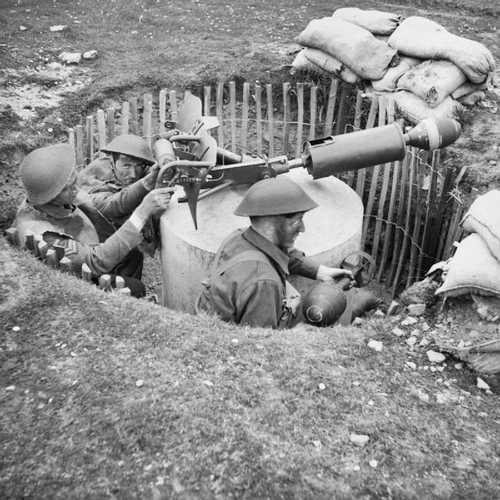
British Forces
Blacker Bombard - fixed mount.
H.M. Government (?)
Three-man Home Guard crew man a Blacker Bombard. The Blacker Bombard was a large spigot mortar grenade launcher, capable of launching a number of grenade types, but conceived primarily as an antitank weapon to help make good the major shortage of conventional antitank guns following the evacuation of the British Expeditionary Force from France, 1940. Unlike its "cousin", the PIAT, the "Blacker" was too large and heavy to be readily mobile. To fire it, one required a large, spider-form mount or, as here, a fixed-position firing pit placed in a strategic location - which might be anything from a sensitive road crossing to an airfield perimeter. Apart from its size/weight/clumsiness in movement, the Blacker's main weakness was its short range. While longer ranges were claimed, the reality was that some 100 metres was its maximum reach - in practice, probably a good deal shorter. Thus, confronting a tank attack, a Blacker Bombard crew would have been close to overrun by the time they could get off one effective shot. Some Blacker Bombards were deployed in North Africa, but it is unclear whether any were used in action. By the time of their deployment there, more effective conventional antitank guns were becoming available to fill the lacuna for which the Blacker Bombard was intended. As a result, most of the weapons went to the Home Guard. Given the weapon's weaknesses, it is perhaps fortunate that the British forces were never forced to rely on it to any significant extent, or that became necessary to rely on it against the panzers on British soil. By the way - there would in their day have been more fixed mount firing pits like this than there were Blacker Bombards - the latter could (with some difficulty) be moved from one such location to another if required. Already by the late-war period, many of their locations were abandoned and forgotten. Even today, one sometimes reveals itself in the gardens of new houses in rural England - not, perhaps, something a new householder wants to find, as it would be difficult to remove. Perhaps converting it to a pond/fountain would be a better option ? Best regards, JR.
2751 Views
5/20/2014
